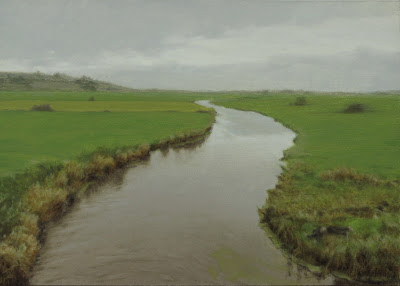oil on card 21x15cm
This is the last of the four small pieces for the Open Eye ‘On a Small Scale’ show. It’s a quiet, early evening scene in a small town in Russia – Alatyr, about halfway between Moscow and the Ural mountains. It was composed as a larger scale painting with a figure - omitted in this one because it’s so very small - which I will no doubt get around to sometime.
I liked the light and the tree masses. It’s from google streetview of course, but not a direct transcription of a single screenshot. The far trees have been shifted leftwards a bit to get the interesting bits in, and I moved the large foreground tree slightly in from the left edge so that it didn’t feel cramped. I’ve also adapted some of the colours by playing up the red and orange top glazes.
I changed my painting technique slightly for this piece. I did the initial setting-out in light pencil because the subject matter was quite complex, and I needed to be as efficient as possible because of time pressure. (Recapping on last month’s ‘Body – Monfréville’, I forgot to mention that I used pencil to indicate the main forms. it was very important to get the curves of the riverbank correct, and that was the easiest and most accurate way to achieve that at 21x15cm.)
After the initial placing, I filled in foliage textures and ground forms with fast-drying thin acrylic ‘grisaille’ layers of Violet Brown Oxide. Once I was happy with that, I progressed with thin semi-opaque oil layers and finished off with glazes. There was no softening or blurring with the fan brush, except in the sky’s two oil paint layers on the white priming. This approach saved a lot of time in the initial stages, and is worth using again in the future. I was very pleased with the violet brown underpainting, and kept seeing it everywhere in real life. I think its oil equivalent is Winsor & Newton’s Mars Violet, and will treat myself to a tube of it for Xmas.
This piece was actually finished in November, but I cynically delayed posting it because I knew I’d got nothing else ready for December. Even though I’m quietly ‘normalising’ after the Events of last month, I‘ve decided not to resume painting until January. I have some official paperwork to follow up, and then there’s Xmas and New Year. There is a work in progress - which ground to a halt in September - on the easel, so I can get on with that if I feel absolutely desperate, but I don’t think it’s worth starting anything major before January. It’s been very interesting and stimulating to produce this little set of four though, and I feel that I’ve learned a useful chunk about how to use my materials (and how not to use them).
It’s always nice to have something on show, and I’m pleased tell you that ’Ghosts’ is currently on the wall at the Union Gallery until 31 January.
And the Open Eye show? Well, we didn’t go to the preview on the Friday evening, but on Saturday morning Madam and I wandered down to the gallery after a late breakfast. All four pieces were up on the walls, and all four had sold. I was quite surprised - she wasn’t though.
Quietly chuffed…










